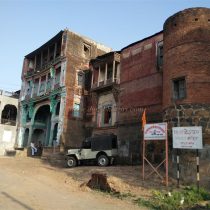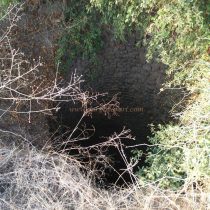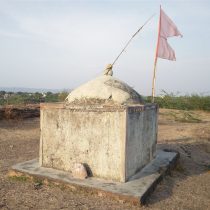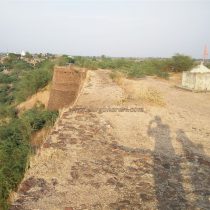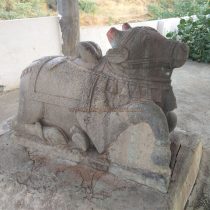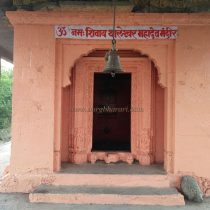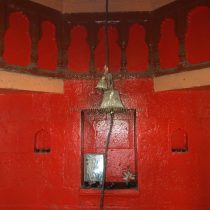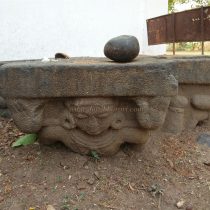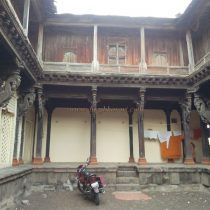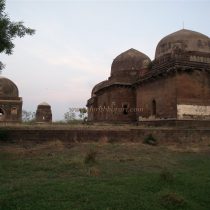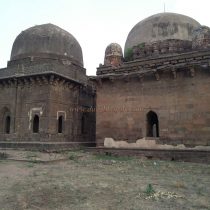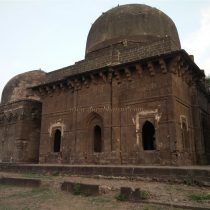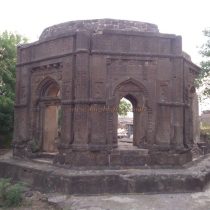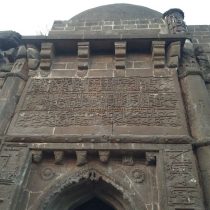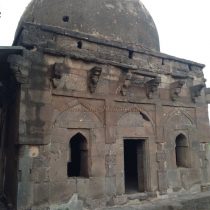THALNER
TYPE : HILL FORT
DISTRICT : DHULE
HEIGHT : 490 FEET
GRADE : EASY
Thalner is a combination of words of ‘thal + ner’. Thal means land and Ner means water. Thalner is a place with rich land and abundant water. About 50 km from Dhule, the fort is located in the village of Thalner on the banks of the river Tapi. Thalner was once the capital of Khandesh and an important center on the Surat-Burhanpur trade route. Thalner is Lata Mangeshkar’s grand-parents house. The river Tapi takes a U-shaped turn near the village of Thalner. There, on a small hill 300 feet high, the fort of Thalner is situated on 3 acres. The fort was fortified on one side by the river Tapi and the other side by ramparts and bastions. The gate on the way to the fort has been destroyed over time. The water of the Tapi river hits the fort and turns west. The entire embankment on this side has collapsed due to the gradual erosion of the hill by this water. Today, only a 60 feet high wall of bricks and 3 bastions stand on the side of the fort's Pataleshwar temple.
...
All the other sidewalls and bastions have collapsed. Due to the large number of thorny shrubs growing in the fort, one has to walk carefully. The citizens of Thalner village have dug the entire fort and took away all the huge stones, clay, and bricks from the fort for the construction of their own houses and other structures. As a result, the fort has been severely damaged. There are two small temples on the fort. One has a recent idol of Goddess Saptashrungi and the other temple is empty. On the outer ramparts of the fort, next to the Pataleshwar temple, there is an idol of Hanuman and a dilapidated sculpture in the adjoining porch. There are two wells on the fort which still have water reserves and the wall of one well has completely collapsed. Apart from this, there are two water cisterns on the fort. As you walk around the fort, you can see pits in two places. One hour is enough to walk around the entire fort. Sthaleshwar is an ancient Shiv temple built in black stone at the base of the fort. There is a Nandi carved in stone in front of the temple and there is a Shivling inside the temple. Although there is not much to see in the fort, there are two places to see in the village. On the way to Pataleshwar Shankar Temple from the village, a fortress catches our attention. The locals call it Jamadar Wada. There are 12-foot-tall brick bastions at the four ends of the mansion. The entrance is 20 feet high and has spiked nails on it. The entrance to the mansion is decorated with wooden carvings. The doors and windows of the rooms inside the mansion are also beautifully carved. The fortress has a basement and a staircase to descend into it. Many families now live in this two-story fortress. The names Ramsingh and Gumansingh are inscribed on the main gate of the fortress. Apart from this, the tombs of kings and important people of the Farooqi dynasty who ruled over Thalner are present in Thalner village. One of the large tombs is octagonal with an Arabic inscription. The rest of the tombs are approximately 11 feet x 11 feet in size. The tombs of four famous kings are as follows: 1) Malik Raja (1396) 2) Malik Nasir (1437) 3) Miran Adilshah (1441) 4) Miran Mubarak Khan (1457). There is also a famous belief about Thalner. Malik Khan was a soldier in the military. When he came to this area for some reason, he saw a strange sight here. When he came to the village, he saw a dog running after a rabbit. While the dog was chasing the rabbit, the rabbit who was running suddenly stopped and attacked the dog. Seeing this, the dog started running back and the rabbit started chasing him. Malik Khan was shocked to see such an unusual incident. He thought that it is the bravery that the rabbit showed due to which he was successful in evading the dog. If we live life with this bravery we will certainly achieve power and establish control of a specific area. So Malik Khan told the landlord about the incident and asked for permission to stay there. The landlord denied this. Malik Khan rushed to Delhi. Delhi was ruled by Sultan Feroze Shah Tughlaq at that time. From this sultan, Malik Khan acquired the parishes of Thalner and Karvand as a Chief in 1370. This was a small but important achievement and returned to Thalner. He captured Thalner and established the power of the Farooqi dynasty there. Excavations at Thalner have revealed a copperplate of Bhanushesh Raja of the Kumbhakarna dynasty dating back to the 6th century. The Kumbhakarna dynasty ruled in the sixth and seventh centuries. It is said that these kings were subordinate kings and there are five kings in that family. Thalner in Shirpur taluka was the capital of East Khandesh. In 1128, the Gawli or Ahir family of Jiwaji and Govaji owned Thalner. When Daulatrao, son of Bajirao, king of Devagiri, came to inspect Khandesh, he found that Thalner was prosperous. So he made Jiwaji and Govaji's family the head of Thalner. In 1370, Feroze Shah Tughlaq conquered the region and bestowed the Subhedari of South Gujarat on Malik Raja Farooqi. Malik made Thalner his capital. In 1370, he came to power and built a fort at Thalner. The following year, the Sultan of Gujarat attacked Malik and captured his territory. Malik went to Thalner to seek shelter. After Malik died in 1399, he handed over his rule of Thalner to his second son, Malik Iftikhar. Therefore, the angry first son Nasir Khan attacked Thalner with the help of the Sultan of Malwa in 1417 and took possession of it. In 1498, Sultan Mohammad Begda of Gujarat conquered Thalner and looted the surrounding area. In 1511, Mohammad Begda awarded half of Khandesh and Thalner to his Wazir Malik Hasanuddin. But the very next year he was assassinated and Thalner was reinstated in Khandesh. In 1566, Sultan Genghis Khan of Gujarat defeated Miran Muhammad Khan, the king of Khandesh. In 1660, the Mughal emperor Akbar defeated Bahadur Shah Farooqi, the last king of the Farooqi dynasty of Khandesh, and the fort of Thalner fell to the Mughals. At that time, the fort on the Surat-Burhanpur trade route was very strong and prosperous. In 1697, Sardar Nemaji Shinde plundered the towns of Nandurbar and Thalner in Khandesh with 8,000 cavalries. He defeated Muslim Sardar Hussain Ali Khan and looted about Rs. 1 lakh 80 thousand. When Thalner came under the control of the Peshwas in 1750, they gave it to the Holkars for making it their military base. In 1800, Holkar gave it to Nimbalkar but took it back the next year. When British General Sir Thomas Hisop went to capture Thalner's fort in 1818, he encountered the strongest resistance of Khandesh. 250 Marathas and 25 British were killed out of which seven of their officers were also killed.
© Suresh Nimbalkar

